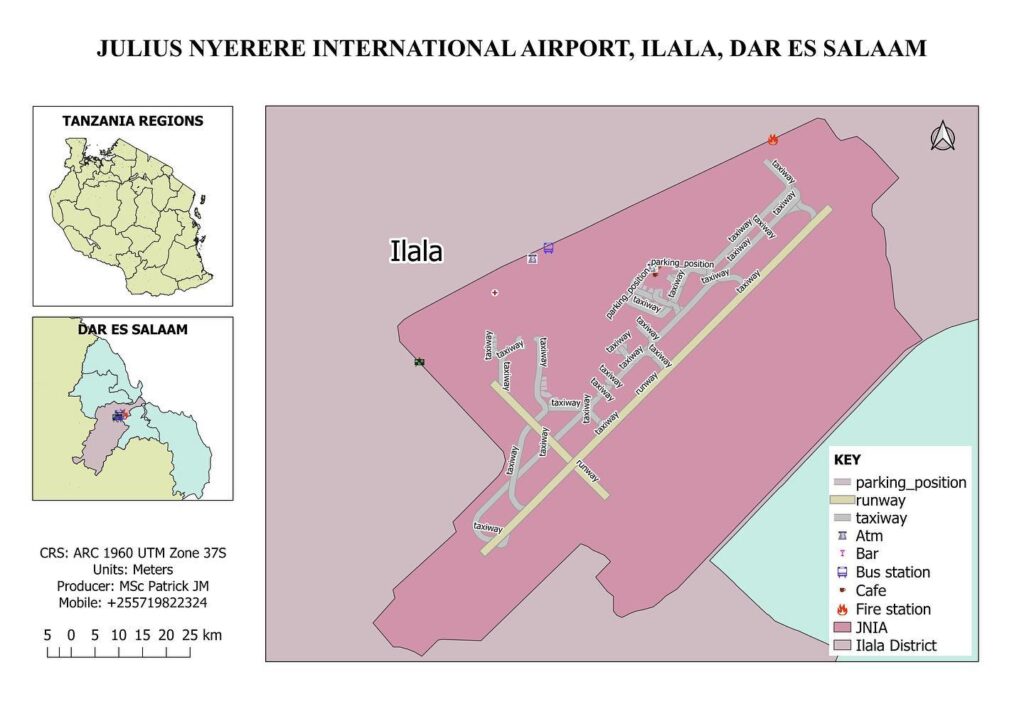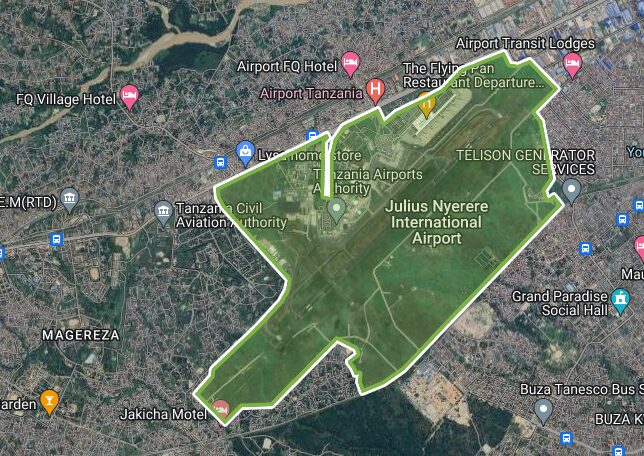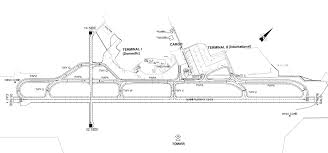Julius Nyerere International Airport (JNIA), located approximately 12 kilometers southwest of Dar es Salaam’s city center, serves as Tanzania’s primary aviation hub. The airport’s layout is designed to facilitate efficient passenger movement and aircraft operations.

Terminals:
- Terminal 1: This terminal caters to chartered and private flights. It is situated separately from the main passenger terminals and is primarily used for smaller aircraft operations.
- Terminal 2: Dedicated to domestic and regional scheduled flights, Terminal 2 handles carriers such as Air Tanzania, Precision Air, and Flightlink. It is located adjacent to Terminal 3, allowing for convenient transfers between domestic and international flights.
- Terminal 3: Opened in August 2019, Terminal 3 is the newest and most modern facility at JNIA, exclusively serving international flights. It features state-of-the-art amenities to accommodate the growing number of international travelers.

Runways and Taxiways
- Runway 05/23 (Primary Runway):
- This is the main operational runway at JNIA, with a length of 3,600 meters (11,811 feet), suitable for handling large commercial and cargo aircraft.
- The orientation is northeast-southwest, designed to accommodate prevailing wind conditions.
- Runway 05/23 is shared by all terminals for both arrivals and departures.
- Taxiways:
- An extensive network of taxiways connects the runway to terminals, aprons, and parking areas.
- Key taxiways run parallel to the main runway, with branches leading directly to Terminals 1, 2, and 3 as well as the cargo apron.
- The taxiways are clearly optimized for smooth ground movement of aircraft, allowing simultaneous taxiing and runway operations.

Terminal Layout
- Terminal 1 (General Aviation):
- Located to the northwest of the airport complex, near the cargo facilities.
- Primarily serves private flights, smaller charters, and VIP operations.
- This terminal is closest to smaller parking aprons and offers quick access for light aircraft.
- Terminal 2 (Domestic & Regional Flights):
- Centrally located within the airport.
- Dedicated to domestic and regional flights, including flights operated by local airlines such as Precision Air and Air Tanzania.
- Features multiple boarding gates and parking stands connected to the main taxiways.
- Terminal 3 (International Flights):
- Positioned to the southeast of the airport and serves as the main terminal for international flights.
- Modern infrastructure caters to long-haul flights operated by airlines such as Emirates, Qatar Airways, Turkish Airlines, KLM, and Ethiopian Airlines.
- Equipped with spacious aprons to accommodate wide-body aircraft like Boeing 777s and Airbus A350s.
- This terminal also houses immigration, customs, and passenger facilities, including duty-free shops, lounges, and restaurants.
Cargo Terminal
- Situated near Terminal 1, the cargo terminal handles freight operations.
- The facility includes dedicated cargo aprons, loading docks, and storage facilities, serving airlines such as Ethiopian Cargo and Turkish Cargo.
- The proximity to the main runway ensures efficient freight handling.
Parking and Aprons
- Aircraft Parking Positions:
- Aprons are allocated for different terminal operations.
- Terminal 1 has smaller aprons for light aircraft.
- Terminal 2 and Terminal 3 feature larger aprons with multiple parking stands for both narrow-body and wide-body aircraft.
- Ground Vehicle Parking:
- Public vehicle parking areas are situated near Terminal 2 and Terminal 3, offering short-term and long-term parking options.
- Enhanced security measures include CCTV surveillance, patrols, and improved lighting.
Supporting Infrastructure
- Control Tower:
- Located centrally for clear visibility of runways, taxiways, and aprons.
- Manages air traffic for departures, arrivals, and ground operations.
- Fire Station:
- Positioned near the runway intersection for rapid response to emergencies.
- Equipped with modern firefighting vehicles and trained personnel.
- Hangars:
- Found in the western part of the airport, these facilities are used for aircraft maintenance and servicing.
- Operated by both Air Tanzania and private operators.
Neighbouring Features
- Geographical Context:
- The airport is situated approximately 12 kilometers (7.5 miles) southwest of Dar es Salaam city center.
- It is bordered by the Ilala District, with residential areas such as Kipawa and Kivule nearby.
- The airport lies adjacent to Nyerere Road, the primary road linking the airport to Dar es Salaam’s central business district (CBD).
- Accessibility:
- JNIA is connected to the city by multiple transportation options, including taxis, buses, and shuttles.
- The nearby Tazara Rail Station provides additional transport access, linking the airport area to regional destinations.
- Surrounding Amenities:
- Hotels near the airport include FQ Village Hotel, Airport Transit Lodges, and The Greenlight Hotel, offering accommodation for passengers in transit.
- Restaurants and cafes, such as The Flying Chef Restaurant, are located in the vicinity for passenger convenience.
Julius Nyerere International Airport (JNIA) Map Overview: Before and After 2019 Expansion
Before 2019, JNIA operated with Terminal 1 for general aviation and VIP services and Terminal 2 for both domestic and international flights. The airport faced congestion due to increasing passenger numbers, with limited apron space, basic cargo facilities, and minimal passenger amenities. A single runway (05/23) served all operations, with constrained taxiway connectivity.
The 2019 expansion introduced Terminal 3, a modern facility exclusively for international flights, while Terminal 2 now handles domestic and regional flights. Terminal 3 features 30 check-in counters, wide-body aircraft aprons, modern lounges, and duty-free shops, elevating JNIA to international standards. Improved taxiways enhance aircraft movement, and additional parking areas cater to travelers near the terminals.
Key Features After Expansion:
- Terminal 1: General aviation and VIP services.
- Terminal 2: Domestic and regional flights.
- Terminal 3: International flights, accommodating 6+ million passengers annually.
- Expanded aprons for wide-body aircraft.
- Enhanced passenger experience with upgraded lounges, retail, and dining.
Neighboring Details: Located near Kipawa and Kivule, the airport has improved access via Nyerere Road and nearby accommodations like Airport Transit Lodges and FQ Village Hotel, now better positioned to serve international travelers. The expansion solidifies JNIA’s role as a key Tanzanian gateway.
